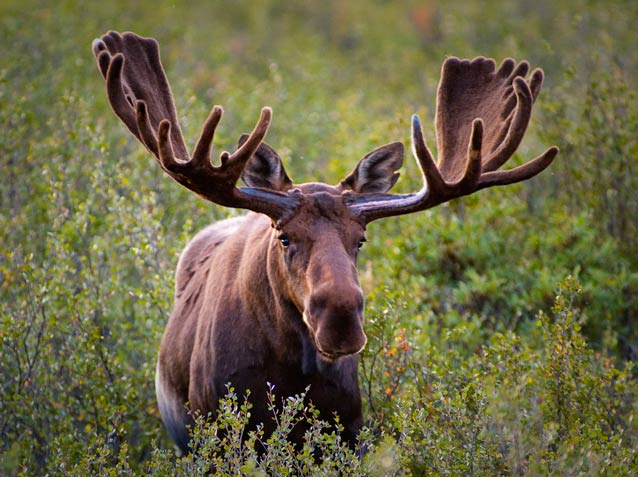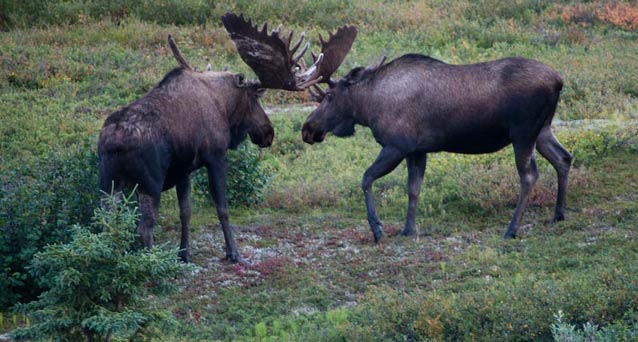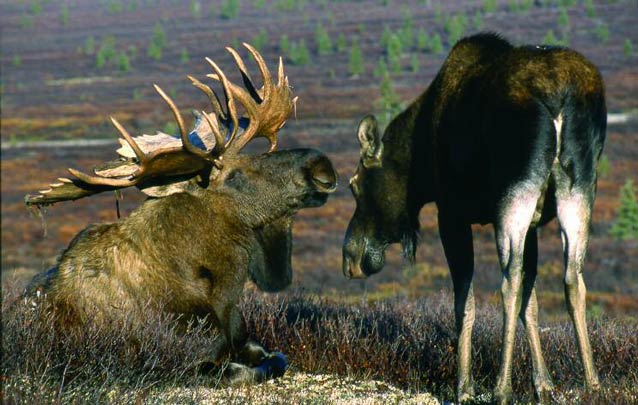Through thirty-plus years of study, biologist Vic Van Ballenberghe knows more about moose behavior than perhaps anyone else (including moose!)
Bull moose are well-equipped to fight. At up to 1,600 pounds they are enormously powerful. Their shoulders are huge, and during the rut, their neck muscles expand to twice their normal size. Thick forehead skin acts like armor against punctures.

NPS Photo / Kent Miller
In 1980, I began a long-term study of moose ecology at Denali National Park and Preserve (Denali). One study component was behavioral ecology—the interrelationships between behavior and ecological factors that moose experience. We were particularly interested in the behavioral ecology of the rutting (mating) season when moose display behaviors not seen at any other time of year. From late August to mid-October, summer feeding gives way to increased social behavior as moose are preoccupied with reproducing.
At Denali we were able accomplish more than other biologists had previously because moose were abundant and observable in most habitats. In addition, we could approach moose closely without disturbing them or placing ourselves in danger.
My colleagues and I were interested in more than just describing moose behavior. That was merely the first step. Much more interesting was the next phase, to develop and test hypotheses that explained the function of these behaviors. Moose evolved certain behaviors for definite reasons, and they invested a lot of energy and time performing them. As we observed moose during the rutting season, numerous questions arose. Why did large bulls cease feeding for two weeks prior to mating? Which bulls were most successful in mating, and what factors determined their success? Why did young males spend so much time sparring?Why did mature bulls risk death by fighting?After we catalogued rutting behavior, we set about conducting studies to answer these and other questions.

NPS Photo / Kent Miller
One topic we were anxious to study was mating success of individual bulls in relation to age, size, and dominance rank. Before studying moose at Denali, I had observed many of them during the autumn rutting season from airplanes. The aerial observations indicated that large bulls controlled groups of cows during the rut, and smaller bulls wandered in search of cows away from groups or hung around the edges of groups hoping to mate when the large bulls were distracted. Although I never saw fights or mating from the air, some of the bulls showed signs that they had fought, including broken antler tines, and mating was obviously occurring. The brief amounts of time that we spent circling moose, often only a few minutes each day, did not allow much opportunity to see important behaviors.
At Denali we were able to spend large amounts of time observing moose on the ground, for the moose had not been hunted for several decades, and there were large numbers of big bulls present. We tried to determine which bulls were most successful at mating and which ones were not, and perhaps explain the difference. We also had radio-collared bulls that we could follow throughout their life, documenting changes in their mating success as they aged.
Despite ideal opportunities to observe rutting moose, it took a long time to acquire enough observations to provide meaningful results. Over a 12-year period we observed mating 86 times. Mating began as early as September 24 and continued as late as October 8. As in other areas of North America, the peak mating for moose was centered on October 1. The rut occurred at the same time each year, evidently independent of differences in temperature or snowfall, suggesting that it was controlled by changes in day length, which remained constant from year to year.

Victor Van Ballenberghe
Ninety-eight percent of observed mating involved females mating with only one male. Very rarely did females mate with two males, and none mated with more than two. Large males performed 88% of all mating, and yearling males accounted for less than two percent. Clearly, the largest, highest-ranking bulls were doing most of the mating. Field observations indicated that they accomplished this by defending cows from smaller bulls, aggressively chasing other bulls away, and by defeating challengers in fights. The lowest ranking animals, including yearlings, had very little success. Even some older males that were small for their age, or were poor fighters, could not compete with the top ranking bulls.
We observed bulls mating up to three times per day, and estimated that some might mate up to 25 times per year if they possessed large groups of cows. This was very rare, however, as bulls seldom were able to control groups throughout the entire rut. Some groups had five or more dominant males by the time the rut was over, each in control for only a few days.
Our results generated several questions about the importance of preserving large bulls in moose populations. In some areas hunting removes many bulls, and the ratio of cows to bulls may be ten to one. At what ratio do some cows fail to mate during the main rutting period? If many cows conceive after the main rut, is the survival of calves affected? If small bulls do most of the mating, are there long-term effects? If most of the small males are successful at mating as opposed to only a few of the large males, how are the genetics of the population affected? These questions are unanswered at present.
Sparring and Fighting
We also studied sparring and fighting. Each is a distinctly different behavior. Sparring is practice fighting that bulls use to gain experience. It superficially resembles fighting as two or more bulls engage their antlers and push each other back and forth. Fighting is far more serious and violent. At worst, sparring results in minor breakage of antlers or perhaps minor wounds inflicted by accident. Fights often result in serious injuries, and at worst, result in death.
If sparring involves learning about fighting and about rivals, inexperienced bulls should participate more than older bulls. Field observations at Denali indicated just that: younger bulls sparred to excess at times, and older bulls rarely sparred. If sparring is merely practice fighting, it should lack preliminary threats and displays. Again, we observed this to be the case: bulls sparred after feeding side-by-side or engaging in some other harmless behavior. Practice sparring should result in no winners or losers, and there should be no serious efforts to wound opponents. Again, bulls observed in the field did not chase each other after sparring, nor did they engage in all-out efforts to crush opponents. Sparring often consisted of little more than gentle antler contact and mild pushing. It did not escalate to fighting and did not determine dominance or rank.
Fights are another matter entirely. Bull moose are well-equipped to fight. At up to 1,600 pounds they are enormously powerful. Their shoulders are huge, and during the rut, their neck muscles expand to twice their normal size. The skin on their foreheads is thick providing armor against punctures by opponents. In addition, they possess weapons and shields in the form of antlers—large, strong organs specifically designed for fighting. Antlers have sharp points attached to broad palms that can severely wound opponents, puncturing the body, injuring eyes, or bruising muscles.
The fights we observed always involved only two opponents, never three or more as sometimes seen in sparring. On occasion, young bulls fought, but most fights were between two mature bulls of approximately equal size. Prior to clashing antlers, fighting bulls engaged in intense displays including pawing the ground, thrashing their antlers against shrubs, and displaying their bodies and antlers. Clashes were extraordinarily violent in an attempt to twist an opponent’s head, shove him backwards, cause him to fall, and gore him. Bulls in fights each sought tactical advantages including gaining the uphill position to maximize battering effects. Losers knew the dangers of remaining nearby and either left or were escorted out of the area by their rivals. Dominant bulls were willing to risk fighting since it is the only way they could control female groups, mate, and pass on their genes—their evolutionary task, which they take very seriously.
Twenty-five years after the study began we are still gathering data on these and other behavioral ecology questions. Data are slow to accumulate at times as the moose population has declined, and field observations are now much more difficult to conduct. We have learned much but each research question generates several others. In the coming years we will continue to uncover some of the biological mysteries of this fascinating species that plays a major role in the ecology of Denali.
Part of a series of articles titled Denali Fact Sheets: Biology.
Next: Moose Surveys
Last updated: February 5, 2015
